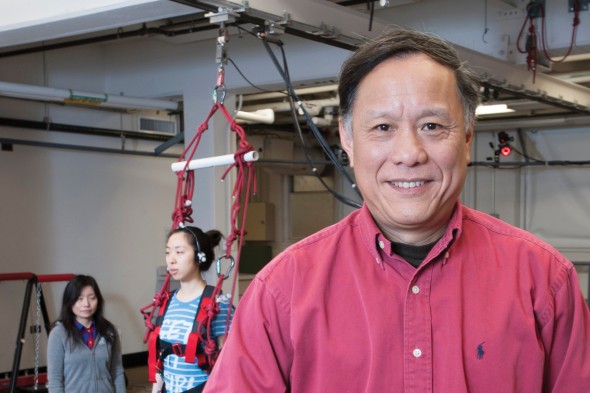Have a good trip, see you next fall: training adults to prevent injury

Clive Pai: “The very first time I saw the reproduction of a fall was fascinating. That’s what’s really kept me going: curiosity.” Photo: Roberta Dupuis-Devlin/UIC Photo Services
The Researcher of the Year Award recognizes 10 UIC scientists who are advancing knowledge in their fields. The Distinguished Researcher Award honors five researchers with a record of outstanding achievement. The Rising Star Award honors early-career researchers who show promise as future leaders.
CLINICAL SCIENCES
Clive Pai
Distinguished Researcher
Clive Pai makes older adults trip and fall, but it’s for their own good.
Strapped safely into a harness, they stride along a special walkway in Pai’s Clinical Gait and Movement Analysis Lab. Suddenly, the surface slides from underneath their feet. It’s a process that can help people learn how to fall, says Pai, professor of physical therapy.
“We mimic a real-life situation,” he says. “In the very first trial, they will fall — and fall badly. But in one, two, three times, they can master the skill and quickly adapt. The amount of memory they have about this learned behavior is astonishing.”
With support from a five-year, $1 million grant from the National Institute on Aging, Pai is developing a computerized treadmill program that could be used in physical therapy offices to help prevent falls and injuries among older adults.
If people learn to fall in a safe environment, Pai says, they will train themselves to improve their protective stepping — movements and resilience that help people recover from instability. “If this approach cannot completely eliminate all falls, it will at the very least make the falls less damaging to the body,” he says. “Falls can be devastating. There’s something we can do to improve a person’s quality of life by reducing the likelihood of a fall and ensuing fractures.”
Pai was a faculty member at Northwestern University before joining UIC in 2000. He began his research on stability at Northwestern, examining how people get up from sitting in a chair. That project provided the framework for his current work. “UIC opened another dimension of what I could explore in terms of movement,” Pai says. “I’ve had a lot of fun with my research.”
His work has been productive, too. He’s received two decades of uninterrupted support from the National Institutes of Health. “I feel very rewarded that during the last 20 years I was able to make a very cohesive story, from the theoretical perspective to the practical application,” he says. “I consider myself very fortunate in the scientific world.”
Pai tells his graduate and doctoral students in biomechanics and physical therapy to find research topics that intrigue them.
“I hope people can find where their passion is,” he says. “The very first time I saw the reproduction of a fall was fascinating to me. That’s what’s really kept me going — curiosity.”
